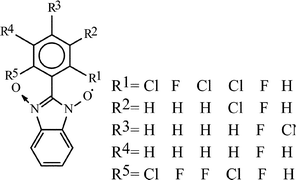Synthesis, structural, and magnetic characterization of substituted benzoimidazole-l-yl N,N′-dioxides
Abstract
The crystal structures, ![[1 with combining macron]](https://www.rsc.org/images/entities/char_0031_0304.gif) . The molecules of 6 are arranged in pairs with short intermolecular distances between the NO groups. 7 crystallizes in two different modifications: polymorph α is orthorhombic, space group Pbca; polymorph β is monoclinic, space group P21/c. 8 crystallizes in two modifications: the α polymorph is monoclinic, space group P21/c; and the β polymorph is monoclinic, space group P21/n. 9 crystallizes in the monoclinic system, space group P21/c. 10 crystallizes in the monoclinic system, space group C2/c. The molecules of 10 are packed in pairs of two types that form a chain perpendicular to the c-axis. 11 crystallizes in the monoclinic crystal system in space group P21/c. The rotation angle between the two rings in compounds 6–10 is 54.2–76.7°. The rotation angle between the two rings is only 21.0° in 11 and it strongly affects the packing of the molecules that adopt the stacking mode. The magnetic measurements show that 6, 7, 10 and 11 exhibit large magnetic coupling. The best fitting with the experimental data for 6 and 11 was obtained using the Bleaney–Bowers singlet–triplet model plus the Curie–Weiss spin impurity (S
= 1/2; H
=
−2J
. The molecules of 6 are arranged in pairs with short intermolecular distances between the NO groups. 7 crystallizes in two different modifications: polymorph α is orthorhombic, space group Pbca; polymorph β is monoclinic, space group P21/c. 8 crystallizes in two modifications: the α polymorph is monoclinic, space group P21/c; and the β polymorph is monoclinic, space group P21/n. 9 crystallizes in the monoclinic system, space group P21/c. 10 crystallizes in the monoclinic system, space group C2/c. The molecules of 10 are packed in pairs of two types that form a chain perpendicular to the c-axis. 11 crystallizes in the monoclinic crystal system in space group P21/c. The rotation angle between the two rings in compounds 6–10 is 54.2–76.7°. The rotation angle between the two rings is only 21.0° in 11 and it strongly affects the packing of the molecules that adopt the stacking mode. The magnetic measurements show that 6, 7, 10 and 11 exhibit large magnetic coupling. The best fitting with the experimental data for 6 and 11 was obtained using the Bleaney–Bowers singlet–triplet model plus the Curie–Weiss spin impurity (S
= 1/2; H
=
−2J S1·S2)
J/kB
=
−84.2 K and θimp
= 0.3 K and J/kB
=
−95.3 K, θimp
= 1.8 K, respectively. A Pade expression for 7 revealed Jintra/kB
= 66.0 K and zJinter/kB
=
−14.0 K. Compound 10 shows evidence for large antiferromagnetic spin coupling (θ
=
−37.0 K Curie–Weiss model).
S1·S2)
J/kB
=
−84.2 K and θimp
= 0.3 K and J/kB
=
−95.3 K, θimp
= 1.8 K, respectively. A Pade expression for 7 revealed Jintra/kB
= 66.0 K and zJinter/kB
=
−14.0 K. Compound 10 shows evidence for large antiferromagnetic spin coupling (θ
=
−37.0 K Curie–Weiss model).


 Please wait while we load your content...
Please wait while we load your content...